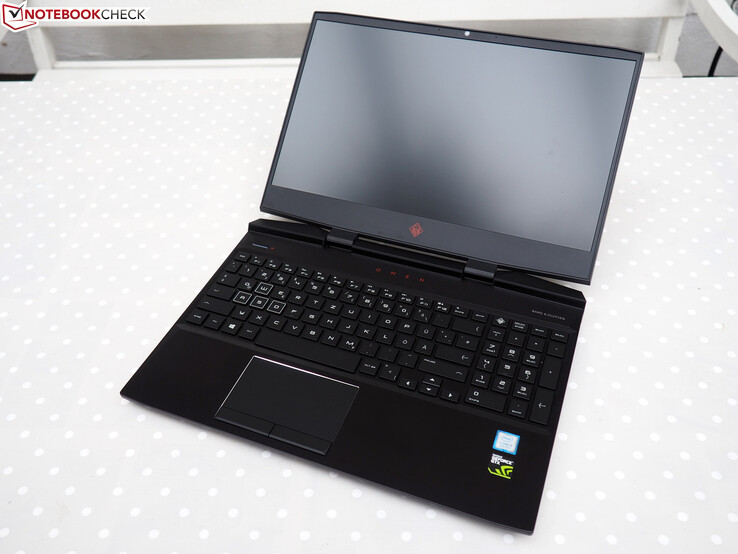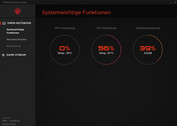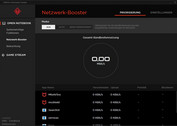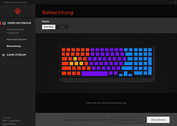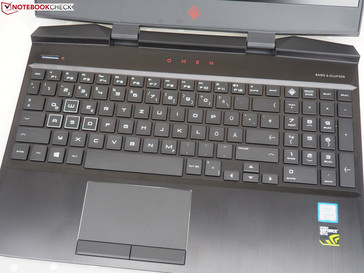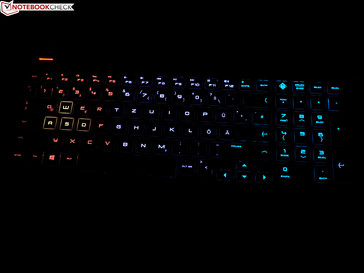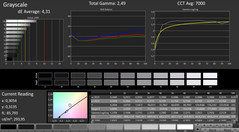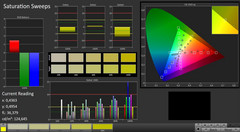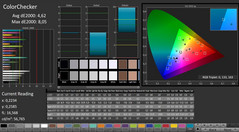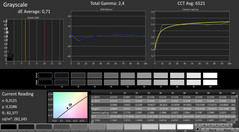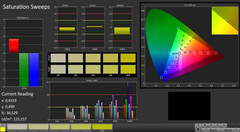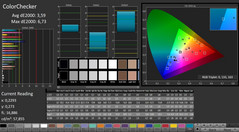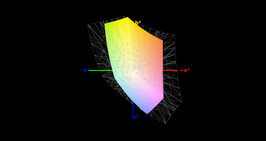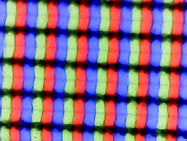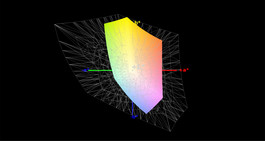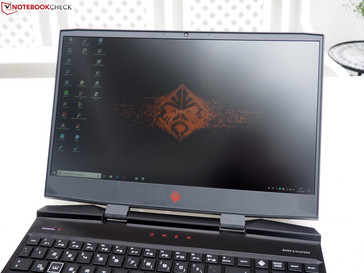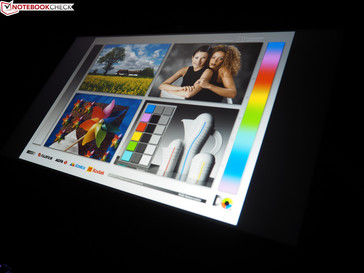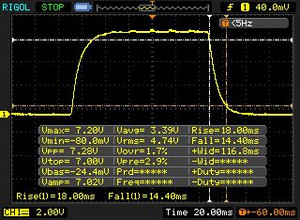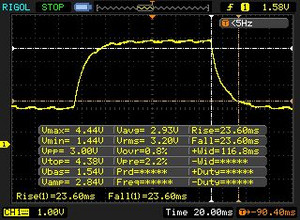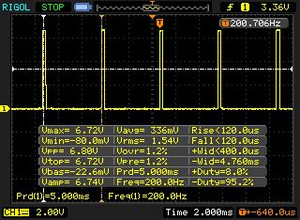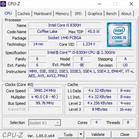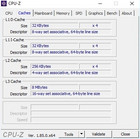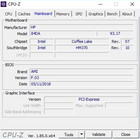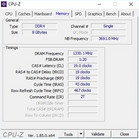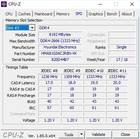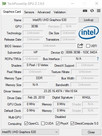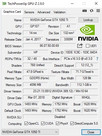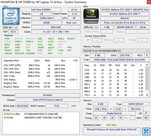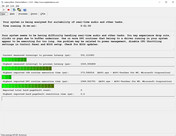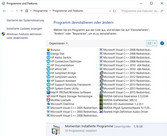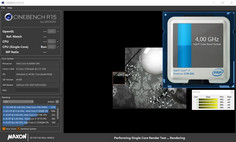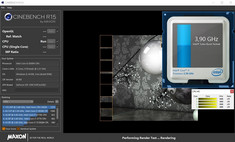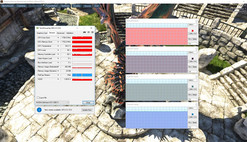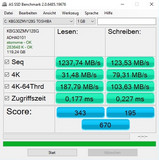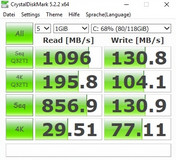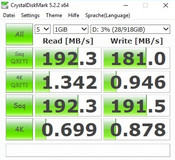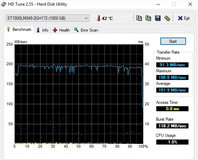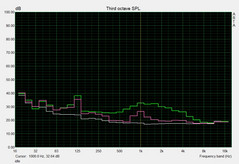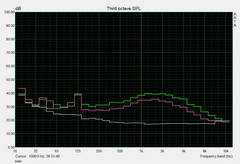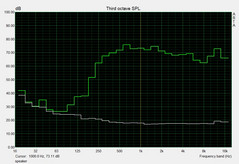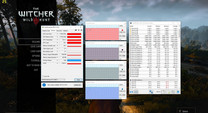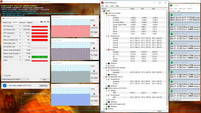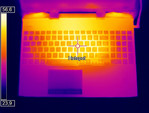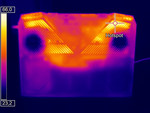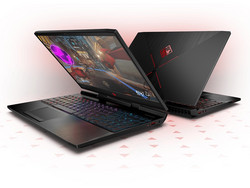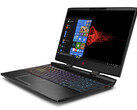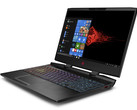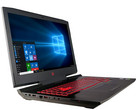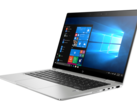HP Omen 15 (i5-8300H, GTX 1050 Ti, FHD) Laptop Review

While the 2017 edition was still based on Intel’s Kaby Lake CPUs HP’s latest 15-inch Omen notebook is designed around the brand-new Coffee Lake platform with four or six cores. Depending on the SKU you either get a Core i5-8300H or a Core i7-8750H.
It is accompanied by between 8 and 32 GB of DDR4 RAM, a 128 to 512 GB SSD, and a 1 TB large hard disk drive. All things graphics-related are relegated to a recent DirectX 12 chip made by Nvidia - either the mid-range GeForce GTX 1050 Ti or the more powerful GeForce GTX 1060 Max-Q or GTX 1070 Max-Q. The display is always an FHD IPS panel (1920x1080).
Our review unit was the base model equipped with a Core i5-8300H, a GeForce GTX 1050 Ti, 8 GB of RAM, and a storage space combination consisting of a 128 GB SSD and a 1 TB HDD. Prices in Europe for this particular base model start at 999 Euros including tax (~$1164). US customers get a slightly different model equipped with 12 instead of 8 GB of RAM, and prices on this side of the Atlantic start at around $920 plus tax.
Its biggest competitors are other budget notebooks from our gaming notebooks top 10 list, including the Xiaomi Mi Gaming and Dell G5 (GeForce GTX 1060 (Max-Q)), the Acer Aspire 7 A715 and Asus GL503VD (GeForce GTX 1050), and the Medion Erazer X6603 (GeForce GTX 1050 Ti).
Case
Despite the many similarities with its predecessor the case has been redesigned quite a bit. Most importantly, the display bezels have been reduced significantly and the overall footprint has been reduced to just 36 x 26.3 x 27.6 cm (14 x 10.4 x 10.9 inches). Many of the available ports have been relocated to the rear of the device, and instead of a continuous hinge the new model features two distinct separate hinges (probably because of the connectivity situation).
What impressed us most was the revised keyboard. Not only did HP remove the hard to read red lettering and replace it with conventional white letters instead, the engineers and designers also updated the formerly uniformly red backlight to several individually adjustable and configurable zones and changed the layout somewhat. More on that later.
Optics and haptics remained largely unchanged. The top case is made of brushed aluminum; the bottom and the display lid are made of textured plastic. Due to the many shape transitions and the ornamental use of colors the design is very distinct without being overly playful.
The overall build quality and structural rigidity matched the device’s price. While the lid was somewhat flexible - a problem found on many notebooks - the rest of the case was very sturdy and, at no more than 2.5 cm (1 inch), also fairly slim. Combined with its moderate weight of just 2.4 kg (5.3 lbs) it was even somewhat portable. Its competitors were all between 2.2 and 2.9 kg (4.9 - 6.4 lbs).
Connectivity
Ports
Lefties will rejoice in regard to the port distribution. HP has decided to relocate several of the ports to the rear end of the notebook meaning that both sides have gained significant elbowroom with regards to external mice. Unfortunately, there are some unnecessary trade-offs to bemoan, most importantly the lack of Thunderbolt 3 that was still present on the predecessor. Instead, the new model’s single USB-C port supports no more than USB 3.1 Gen1, which constitutes a massive downgrade. However, Thunderbolt 3 is destined to return on the not yet available more expensive and more powerful SKUs.
The rest of the ports have remained unchanged. The 15-inch notebook thus still contains an SD card reader, three USB 3.0 Type-A ports, a fold-out RJ45 Ethernet port, two audio ports (audio-out, microphone-in), HDMI, DisplayPort, and last but not least a Kensington lock.
SD Card Reader
At 78-87 MB/s the card reader’s performance was similar to the previous model. In the global scheme of things it was mediocre at best, although we must add that not a single one of our competitors was capable of maxing out our 260 MB/s reference card. At the low end of the spectrum the Dell G5’s and the Xiaomi Mi Gaming Laptop’s card readers managed no more than USB 2.0 speeds.
| SD Card Reader | |
| average JPG Copy Test (av. of 3 runs) | |
| HP Omen 15-dc0001ng (Toshiba Exceria Pro SDXC 64 GB UHS-II) | |
| HP Omen 15-ce002ng (Toshiba Exceria Pro SDXC 64 GB UHS-II) | |
| Acer Aspire 7 A715-71G-53TU (Toshiba Exceria Pro SDXC 64 GB UHS-II) | |
| Medion Erazer X6603 (oshiba Exceria Pro SDXC 64 GB UHS-II) | |
| Asus GL503VD-DB74 | |
| Xiaomi Mi Gaming Laptop 7300HQ 1060 (Toshiba Exceria Pro SDXC 64 GB UHS-II) | |
| Dell G5 15 5587 (Toshiba Exceria Pro SDXC 64 GB UHS-II) | |
| maximum AS SSD Seq Read Test (1GB) | |
| Asus GL503VD-DB74 | |
| HP Omen 15-ce002ng (Toshiba Exceria Pro SDXC 64 GB UHS-II) | |
| HP Omen 15-dc0001ng (Toshiba Exceria Pro SDXC 64 GB UHS-II) | |
| Acer Aspire 7 A715-71G-53TU (Toshiba Exceria Pro SDXC 64 GB UHS-II) | |
| Medion Erazer X6603 (oshiba Exceria Pro SDXC 64 GB UHS-II) | |
| Dell G5 15 5587 (Toshiba Exceria Pro SDXC 64 GB UHS-II) | |
| Xiaomi Mi Gaming Laptop 7300HQ 1060 (Toshiba Exceria Pro SDXC 64 GB UHS-II) | |
Communication
As expected of a modern notebook the Omen 15 comes with an up-to-date wireless modem: Intel’s Wireless-AC 9560. When connected to our Linksys EA8500 reference router it managed more than 600 Mbps in both transmit and receive (1 m distance between the two devices). The predecessor’s Intel Wireless-AC 7265 was significantly slower when transmitting data.
Software
Nowadays, almost every gaming notebook comes with its own tuning and monitoring software, and the HP Omen 15 is no exception. The preinstalled software called Command Center shows CPU, GPU, and RAM load and temperatures as well as network traffic. It can be used to configure the keyboard backlight but lacks any form of overclocking capabilities.
Accessories
The only items we found in the box in addition to the notebook itself were a quick-start guide and the surprisingly compact (14 x 6.5 x 2 cm / 5.5 x 2.6 x 0.8 inches) and lightweight 150 W power supply.
Maintenance
Unfortunately, we were unable to assess the Omen 15’s maintainability. Even after removing every single Phillips screw at the bottom the cover was still firmly affixed to the case. Accordingly, we feared that we would damage the notebook if we continued trying to pry it open and eventually gave up. After all, we did not want to damage our shop unit provided by cyperport.de. That being said, we expect the internals to be largely identical to the predecessor. Please refer to the previous review for details and photos.
Warranty
As usual, US customers are deprived of the second year of warranty that European customers must have grown accustomed to at this point. Please see our Guarantees, Return policies and Warranties FAQ for country-specific information.
Input Devices
Keyboard
The keyboard turned out to be very decent. In addition to the single-stage multi-color backlight we were particularly fond of the new color for the labels, which had a massive impact on legibility. Typing was decent and will probably satisfy most users. Don’t expect top-class performance regarding accentuation point or feedback, though.
Despite the overall fairly narrow case HP has managed to fit a numpad next to the regular-sized chiclet-style keyboard. However, the layout was a bit of a challenge as it deviated significantly from the default German keyboard layout. Take a look at for example the single-row Return key, the relocated ><| key, or the missing right CTRL key. Basically, HP took the regular US QWERTY layout and simply remapped some keys instead of adjusting the layout accordingly. US customers will find a regular QWERTY keyboard layout with teeny-tiny cursor keys that are almost impossible to use for gaming.
Touchpad
The silver-framed and slightly recessed touchpad was inconspicuous by and large. In other words: It was neither particularly good nor particularly bad. That not only applied to precision but also to smoothness. Gestures generally worked very well, although we noticed a minor input lag when performing them.
At 10.2 x 5.7 cm (4 x 2.2 inches) the touchpad was adequately sized for a 15-inch notebook. Unlike many other manufacturers HP has opted against a ClickPad and for two dedicated mouse buttons below the touch surface, which improved overall precision noticeably.
Display
Our review unit’s FHD display left us with mixed feelings. On the bright side its contrast ratio was very decent (1,019:1) thanks to its low black level of just 0.27 nits.
| |||||||||||||||||||||||||
Brightness Distribution: 90 %
Center on Battery: 275 cd/m²
Contrast: 1019:1 (Black: 0.27 cd/m²)
ΔE Color 4.62 | 0.5-29.43 Ø5, calibrated: 3.59
ΔE Greyscale 4.31 | 0.57-98 Ø5.3
59% sRGB (Argyll 1.6.3 3D)
38% AdobeRGB 1998 (Argyll 1.6.3 3D)
40.95% AdobeRGB 1998 (Argyll 2.2.0 3D)
59% sRGB (Argyll 2.2.0 3D)
39.64% Display P3 (Argyll 2.2.0 3D)
Gamma: 2.49
| HP Omen 15-dc0001ng BOE07A1, IPS, 1920x1080 | HP Omen 15-ce002ng AUO42ED, IPS, 1920x1080 | Dell G5 15 5587 LGD053F, 156WF6, IPS, 1920x1080 | Xiaomi Mi Gaming Laptop 7300HQ 1060 BOEhydis NV156FHM-N61 (BOE0747), IPS, 1920x1080 | Medion Erazer X6603 LP156WF6-SPK3, AH-IPS, LED, 1920x1080 | Acer Aspire 7 A715-71G-53TU BOE NV156FHM-N42 , a-Si TFT-LCD, IPS, 1920x1080 | Asus GL503VD-DB74 LG Philips LP156WF6, IPS, 1920x1080 | |
|---|---|---|---|---|---|---|---|
| Display | 61% | -4% | 57% | -7% | 2% | 52% | |
| Display P3 Coverage | 39.64 | 65.8 66% | 38.13 -4% | 66.6 68% | 36.82 -7% | 40.53 2% | 64.3 62% |
| sRGB Coverage | 59 | 90.9 54% | 56.8 -4% | 87.3 48% | 54.9 -7% | 59.9 2% | 84.4 43% |
| AdobeRGB 1998 Coverage | 40.95 | 66.5 62% | 39.47 -4% | 63.8 56% | 38.09 -7% | 41.87 2% | 61.7 51% |
| Response Times | 6% | 28% | 3545% | 333% | 3295% | 3482% | |
| Response Time Grey 50% / Grey 80% * | 47.2 ? | 43.2 ? 8% | 33 ? 30% | 53.2 ? -13% | 46 ? 3% | 49 ? -4% | 36.4 ? 23% |
| Response Time Black / White * | 32.4 ? | 31.2 ? 4% | 24 ? 26% | 41.6 ? -28% | 29 ? 10% | 36 ? -11% | 26.2 ? 19% |
| PWM Frequency | 200 ? | 21550 ? 10675% | 2174 ? 987% | 20000 ? 9900% | 21010 ? 10405% | ||
| Screen | 22% | -23% | 15% | -23% | -1% | 5% | |
| Brightness middle | 275 | 304 11% | 229 -17% | 283 3% | 252 -8% | 267 -3% | 315.9 15% |
| Brightness | 254 | 289 14% | 224 -12% | 269 6% | 246 -3% | 250 -2% | 304 20% |
| Brightness Distribution | 90 | 86 -4% | 87 -3% | 87 -3% | 94 4% | 82 -9% | 88 -2% |
| Black Level * | 0.27 | 0.26 4% | 0.28 -4% | 0.23 15% | 0.23 15% | 0.31 -15% | 0.37 -37% |
| Contrast | 1019 | 1169 15% | 818 -20% | 1230 21% | 1096 8% | 861 -16% | 854 -16% |
| Colorchecker dE 2000 * | 4.62 | 3.46 25% | 6.1 -32% | 4.68 -1% | 7.83 -69% | 4.65 -1% | 4.9 -6% |
| Colorchecker dE 2000 max. * | 8.05 | 7.72 4% | 12.2 -52% | 8 1% | 15.5 -93% | 8.2 -2% | 9.7 -20% |
| Colorchecker dE 2000 calibrated * | 3.59 | 6.12 -70% | 2.5 30% | ||||
| Greyscale dE 2000 * | 4.31 | 2.46 43% | 5.68 -32% | 4.32 -0% | 7.11 -65% | 2.65 39% | 3.8 12% |
| Gamma | 2.49 88% | 2.38 92% | 2.4 92% | 2.36 93% | 2.19 100% | 2.44 90% | 2.24 98% |
| CCT | 7000 93% | 6915 94% | 6989 93% | 7612 85% | 7930 82% | 6820 95% | 6847 95% |
| Color Space (Percent of AdobeRGB 1998) | 38 | 59 55% | 36 -5% | 57 50% | 35 -8% | 38 0% | 55 45% |
| Color Space (Percent of sRGB) | 59 | 91 54% | 57 -3% | 87 47% | 55 -7% | 59 0% | 84 42% |
| Total Average (Program / Settings) | 30% /
28% | 0% /
-13% | 1206% /
646% | 101% /
47% | 1099% /
618% | 1180% /
666% |
* ... smaller is better
Nevertheless, the display seemed very dull and pale, and we quickly found the culprit: Its color-space coverage was abysmal. 59% sRGB and 38% AdobeRGB are very poor results even for a gaming notebook. That being said, we should add that the Dell G5, the Medion Erazer X6603, and the Acer Aspire 7 did not do particularly well in this regard either. The notable exceptions were the Asus GL503VD and the Xiaomi Mi Gaming Laptop.
Response times were also too high. 32 ms black-to-white and 47 ms gray-to-gray are quite poor for a gaming device. The Gigabyte Aero 15X, the Razer Blade 15, the MSI GS65, and the Schenker XMG Neo 15 have much faster IPS panels.
Last but not least let’s address the elephant in the room: display brightness. At just 254 nits on average the Omen 15’s display was too dark even for indoor usage and rendered completely useless outdoors by even the tiniest amount of sunshine. At least the 60 Hz panel featured decent viewing angles with just minor and mostly unnoticeable halations in the corners that were only visible in situations with dark and/or unicolored backgrounds.
Display Response Times
| ↔ Response Time Black to White | ||
|---|---|---|
| 32.4 ms ... rise ↗ and fall ↘ combined | ↗ 18 ms rise | |
| ↘ 14.4 ms fall | ||
| The screen shows slow response rates in our tests and will be unsatisfactory for gamers. In comparison, all tested devices range from 0.1 (minimum) to 240 (maximum) ms. » 86 % of all devices are better. This means that the measured response time is worse than the average of all tested devices (21.5 ms). | ||
| ↔ Response Time 50% Grey to 80% Grey | ||
| 47.2 ms ... rise ↗ and fall ↘ combined | ↗ 23.6 ms rise | |
| ↘ 23.6 ms fall | ||
| The screen shows slow response rates in our tests and will be unsatisfactory for gamers. In comparison, all tested devices range from 0.2 (minimum) to 636 (maximum) ms. » 79 % of all devices are better. This means that the measured response time is worse than the average of all tested devices (33.7 ms). | ||
Screen Flickering / PWM (Pulse-Width Modulation)
| Screen flickering / PWM detected | 200 Hz | ≤ 99 % brightness setting | |
The display backlight flickers at 200 Hz (worst case, e.g., utilizing PWM) Flickering detected at a brightness setting of 99 % and below. There should be no flickering or PWM above this brightness setting. The frequency of 200 Hz is relatively low, so sensitive users will likely notice flickering and experience eyestrain at the stated brightness setting and below. In comparison: 53 % of all tested devices do not use PWM to dim the display. If PWM was detected, an average of 17924 (minimum: 5 - maximum: 3846000) Hz was measured. | |||
Performance
Based on our review unit’s hardware - Core i5-8300H CPU, GeForce GTX 1050 Ti GPU, 8 GB single-channel RAM - the Omen 15 would be considered an upper mid-range device. The CPU and GPU are soldered onto the motherboard but the RAM can be upgraded up to 32 GB (2x 16 GB). In theory, upgrading the storage devices (1x M.2, 1x 2.5-inch) is also possible.
Processor
Given the immense cooling requirements and the fact that most games are GPU instead of CPU bound it makes perfect sense that HP opted for the quad-core Core i5-8300H CPU instead of the hexa-core Core i5-8750H in the low-end SKU. After all, it is still more than powerful enough for everyday applications.
The Coffee Lake CPU has access to 8 MB of cache and can turbo-boost up to 4 GHz. In reality, the maximum turbo boost measured by us was 3.9 GHz during the first few seconds of our 30-minute long Cinebench R15 loop, after which it dropped to around 3.3 GHz.
By and large, the scores remained fairly consistent. Laptops equipped with the more powerful yet also more demanding Core i7-8750H often have trouble keeping performance at a consistent level. Compared with the Core i7-7700HQ the new CPU was just 10% faster but was a whopping 50% faster when compared with its direct predecessor, the Core i5-7300HQ (which still lacked support for Hyper-Threading).
System Performance
Thanks to our base model’s SSD the PCMark scores were at an acceptable level and good enough for overall third place in PCMark 10. The operating system booted very quickly and felt very snappy during everyday use.
| PCMark 10 - Score | |
| Dell G5 15 5587 | |
| HP Omen 15-ce002ng | |
| HP Omen 15-dc0001ng | |
| Medion Erazer X6603 | |
| Asus GL503VD-DB74 | |
| Xiaomi Mi Gaming Laptop 7300HQ 1060 | |
| Acer Aspire 7 A715-71G-53TU | |
| PCMark 8 Home Score Accelerated v2 | 4109 points | |
| PCMark 8 Work Score Accelerated v2 | 5362 points | |
| PCMark 10 Score | 4707 points | |
Help | ||
Storage Devices
The Omen 15’s storage devices failed to meet our expectations. The 128 GB Toshiba M.2 PCIe SSD (KBG30ZMV128G) offered a very fast read performance on a par with its competitors but an incredibly poor write performance akin to a spinning disk drive. This poor write performance became very noticeable during everyday use, for example when installing software or Windows updates or when transferring data onto the drive. In AS SSD, 80% of its competitors were faster than the Omen 15.
A secondary Seagate Barracuda Pro ST1000LM049 was installed in our review unit’s 2.5-inch slot. This particular model offered 1 TB capacity and operated at 7,200 rpm.
| HP Omen 15-dc0001ng Toshiba KBG30ZMV128G | Dell G5 15 5587 SK hynix SC311 M.2 | Xiaomi Mi Gaming Laptop 7300HQ 1060 Samsung PM871b MZNLN128HAHQ | Medion Erazer X6603 Samsung PM961 MZVLW256HEHP | Acer Aspire 7 A715-71G-53TU Kingston RBUSNS8180DS3128GH | Asus GL503VD-DB74 ADATA SX7000NP 256 GB | |
|---|---|---|---|---|---|---|
| AS SSD | -7% | 48% | 257% | 51% | 155% | |
| Seq Read | 1238 | 511 -59% | 502 -59% | 2805 127% | 488.4 -61% | 1226 -1% |
| Seq Write | 123.5 | 243.7 97% | 450.1 264% | 1081 775% | 394.2 219% | 825 568% |
| 4K Read | 31.48 | 24.44 -22% | 38.11 21% | 46.58 48% | 36.25 15% | 31.4 0% |
| 4K Write | 79.3 | 62.2 -22% | 104.1 31% | 129.3 63% | 64.7 -18% | 110.7 40% |
| Score Read | 343 | 240 -30% | 343 0% | 1162 239% | 460 34% | 419 22% |
| Score Write | 195 | 199 2% | 302 55% | 750 285% | 395 103% | 851 336% |
| Score Total | 670 | 557 -17% | 834 24% | 2431 263% | 1099 64% | 1476 120% |
GPU Performance
If you’re on a budget and willing to make sacrifices in regard to in-game details then the GeForce GTX 1050 Ti is the perfect card. The Pascal chip supports DirectX 12 and has access to 4 GB of GDDR5 VRAM. In other words: It is a perfect compromise between price and performance.
| 3DMark 11 Performance | 8908 points | |
| 3DMark Cloud Gate Standard Score | 22454 points | |
| 3DMark Fire Strike Score | 6653 points | |
Help | ||
Just like the CPU, the GPU was also capable of utilizing its turbo potential fairly well. In 3D applications it often ran much faster than its base clock speed of 1,493 MHz: For example a nigh perfect 1,709 MHz during our 60-minute The Witcher 3 loop (FHD/Ultra). The maximum was measured at 1,759 MHz according to GPU-Z’s render test.
Our benchmarks were completed very similar to the Medion Erazer X6603 that was equipped with the exact same GPU. The Omen 15 was around 20-30% faster than its GeForce GTX 1050 competitors and approximately 30-40% slower than a GeForce GTX 1060 Max-Q device. In 3DMark 13’s Fire Strike a GeForce GTX 1060 performed up to 50% faster.
| 3DMark - 1920x1080 Fire Strike Graphics | |
| Xiaomi Mi Gaming Laptop 7300HQ 1060 | |
| Dell G5 15 5587 | |
| HP Omen 15-ce002ng | |
| Medion Erazer X6603 | |
| HP Omen 15-dc0001ng | |
| Acer Aspire 7 A715-71G-53TU | |
| Asus GL503VD-DB74 | |
| 3DMark 11 - 1280x720 Performance GPU | |
| Xiaomi Mi Gaming Laptop 7300HQ 1060 | |
| Dell G5 15 5587 | |
| HP Omen 15-ce002ng | |
| Medion Erazer X6603 | |
| HP Omen 15-dc0001ng | |
| Acer Aspire 7 A715-71G-53TU | |
| Asus GL503VD-DB74 | |
Gaming Performance
As long as you restrict yourself to the Omen 15’s panel’s native FHD resolution of 1920x1080 and don’t try gaming on external WQHD or 4K displays most games will run very smoothly in high or maximum details. Only very demanding titles, such as The Witcher 3, might be somewhat problematic.
| The Witcher 3 | |
| 1920x1080 Ultra Graphics & Postprocessing (HBAO+) | |
| Xiaomi Mi Gaming Laptop 7300HQ 1060 | |
| Dell G5 15 5587 | |
| HP Omen 15-ce002ng | |
| HP Omen 15-dc0001ng | |
| Asus GL503VD-DB74 | |
| 1920x1080 High Graphics & Postprocessing (Nvidia HairWorks Off) | |
| Xiaomi Mi Gaming Laptop 7300HQ 1060 | |
| HP Omen 15-ce002ng | |
| Dell G5 15 5587 | |
| HP Omen 15-dc0001ng | |
For reasons of pricing and in order to keep power consumption low the entry-level SKU lacks features such as G-Sync or 120/144 Hz displays. In return, our review unit supported Optimus-switching graphics, which means it dynamically switched between the internal UHD Graphics 630 and the external GeForce GPU on demand.
| low | med. | high | ultra | |
| The Witcher 3 (2015) | 44.2 | 24.2 | ||
| Rainbow Six Siege (2015) | 88.3 | 66.6 | ||
| Overwatch (2016) | 117 | 71 | ||
| Mirror's Edge Catalyst (2016) | 47.5 | 43.3 | ||
| Farming Simulator 17 (2016) | 153 | 114 | ||
| Destiny 2 (2017) | 62.8 | 51.2 |
Emissions
System Noise
One of the biggest challenges of the Omen 15’s slim design is proper cooling. Like almost all gaming notebooks our review unit got very loud under load, and at 47 dB(A) while running The Witcher 3 it was quieter than the Xiaomi Mi Gaming Laptop (50 dB(A)) but noticeably louder than the Dell G5 and its Max-Q GPU at just 43 dB(A).
The cooling solution was much better when idle, although the fans did rev up occasionally even then. Most of the time, however, they were either spinning very slowly or turned off completely. In these situations the only sound we could hear was the spinning hard disk drive.
Noise Level
| Idle |
| 29 / 33 / 41 dB(A) |
| HDD |
| 33 dB(A) |
| Load |
| 44 / 49 dB(A) |
 | ||
30 dB silent 40 dB(A) audible 50 dB(A) loud |
||
min: | ||
| HP Omen 15-dc0001ng GeForce GTX 1050 Ti Mobile, i5-8300H | HP Omen 15-ce002ng GeForce GTX 1060 Max-Q, i7-7700HQ | Dell G5 15 5587 GeForce GTX 1060 Max-Q, i5-8300H | Xiaomi Mi Gaming Laptop 7300HQ 1060 GeForce GTX 1060 Mobile, i5-7300HQ | Medion Erazer X6603 GeForce GTX 1050 Ti Mobile, i7-7700HQ | Acer Aspire 7 A715-71G-53TU GeForce GTX 1050 Mobile, i5-7300HQ | Asus GL503VD-DB74 GeForce GTX 1050 Mobile, i7-7700HQ | |
|---|---|---|---|---|---|---|---|
| Noise | 3% | 7% | -3% | 7% | 10% | 4% | |
| off / environment * | 29 | 30 -3% | 30.3 -4% | 30 -3% | 30.9 -7% | 30.4 -5% | 28.3 2% |
| Idle Minimum * | 29 | 30 -3% | 31.1 -7% | 30 -3% | 30.9 -7% | 30.4 -5% | 30.6 -6% |
| Idle Average * | 33 | 33 -0% | 31.1 6% | 34 -3% | 30.9 6% | 30.8 7% | 30.8 7% |
| Idle Maximum * | 41 | 37 10% | 34.2 17% | 38 7% | 31.6 23% | 30.8 25% | 32.8 20% |
| Load Average * | 44 | 41 7% | 34.9 21% | 44 -0% | 38.5 12% | 33.6 24% | 37.6 15% |
| Witcher 3 ultra * | 47 | 42 11% | 42.7 9% | 50 -6% | 47 -0% | ||
| Load Maximum * | 49 | 50 -2% | 44 10% | 55 -12% | 40.8 17% | 43.4 11% | 53.5 -9% |
* ... smaller is better
Temperature
Surface temperatures remained almost identical to the previous model. When idle, the case reached a maximum of 28-35 °C (83 - 95 °F) due to the turned-off fans. Under 3D load the rear third of the case was the hottest part of the device and reached top and bottom maximums of 51 °C (124 F) and 58 °C (136 °F), respectively. Luckily the palm rests remained comparatively cool at just 42 °C (108 °F). The Dell G5 was very similar under 3D load while the Medion Erazer X6603 and the Acer Aspire 7 remained noticeably cooler.
As always, we ran our usual stress test of at least one full hour of Prime95 and FurMark simultaneously. After one hour, the GPU had reached a maximum of 83 °C (182 °F) - a more than acceptable temperature that was achieved by throttling the GPU. The Core i5-8300H, on the other hand, recorded a very high maximum of 99 °C (210 °F) while running at a turbo boost clock speed of 3.3 GHz. Nevertheless, the cooling solution seemed to have reached its limits with the quad-core already and we strongly suspect that the i7-8750H will be too much for the Omen 15’s coolers and fans.
(-) The maximum temperature on the upper side is 51 °C / 124 F, compared to the average of 40.4 °C / 105 F, ranging from 21.2 to 68.8 °C for the class Gaming.
(-) The bottom heats up to a maximum of 58 °C / 136 F, compared to the average of 43.2 °C / 110 F
(±) In idle usage, the average temperature for the upper side is 32 °C / 90 F, compared to the device average of 33.8 °C / 93 F.
(-) Playing The Witcher 3, the average temperature for the upper side is 42 °C / 108 F, compared to the device average of 33.8 °C / 93 F.
(-) The palmrests and touchpad can get very hot to the touch with a maximum of 42 °C / 107.6 F.
(-) The average temperature of the palmrest area of similar devices was 28.9 °C / 84 F (-13.1 °C / -23.6 F).
| HP Omen 15-dc0001ng GeForce GTX 1050 Ti Mobile, i5-8300H | HP Omen 15-ce002ng GeForce GTX 1060 Max-Q, i7-7700HQ | Dell G5 15 5587 GeForce GTX 1060 Max-Q, i5-8300H | Xiaomi Mi Gaming Laptop 7300HQ 1060 GeForce GTX 1060 Mobile, i5-7300HQ | Medion Erazer X6603 GeForce GTX 1050 Ti Mobile, i7-7700HQ | Acer Aspire 7 A715-71G-53TU GeForce GTX 1050 Mobile, i5-7300HQ | Asus GL503VD-DB74 GeForce GTX 1050 Mobile, i7-7700HQ | |
|---|---|---|---|---|---|---|---|
| Heat | -1% | 10% | 10% | 26% | 19% | -2% | |
| Maximum Upper Side * | 51 | 47 8% | 50.2 2% | 46 10% | 44.3 13% | 41.6 18% | 60.4 -18% |
| Maximum Bottom * | 58 | 54 7% | 57 2% | 52 10% | 39.5 32% | 42.5 27% | 55.2 5% |
| Idle Upper Side * | 35 | 36 -3% | 28.6 18% | 32 9% | 24.8 29% | 29.7 15% | 32.4 7% |
| Idle Bottom * | 35 | 40 -14% | 28.9 17% | 32 9% | 24.6 30% | 29.4 16% | 36 -3% |
* ... smaller is better
Speakers
Even though on paper our review unit’s sound performance was slightly worse than its predecessor’s we would still consider the 2.0 system to be acceptable and decent. As is almost always the case with notebook speakers they lack volume, dynamic range, and precision. Accordingly, we would still suggest using a headset or external speakers for an improved audio experience. As an interim solution the internal speakers will do, however.
HP Omen 15-dc0001ng audio analysis
(+) | speakers can play relatively loud (83 dB)
Bass 100 - 315 Hz
(-) | nearly no bass - on average 20.5% lower than median
(±) | linearity of bass is average (13.5% delta to prev. frequency)
Mids 400 - 2000 Hz
(+) | balanced mids - only 4.1% away from median
(+) | mids are linear (4.7% delta to prev. frequency)
Highs 2 - 16 kHz
(+) | balanced highs - only 1.9% away from median
(+) | highs are linear (4.4% delta to prev. frequency)
Overall 100 - 16.000 Hz
(±) | linearity of overall sound is average (15.9% difference to median)
Compared to same class
» 35% of all tested devices in this class were better, 7% similar, 59% worse
» The best had a delta of 6%, average was 18%, worst was 132%
Compared to all devices tested
» 20% of all tested devices were better, 5% similar, 75% worse
» The best had a delta of 4%, average was 25%, worst was 134%
HP Omen 15-ce002ng audio analysis
(±) | speaker loudness is average but good (80 dB)
Bass 100 - 315 Hz
(±) | reduced bass - on average 12.9% lower than median
(±) | linearity of bass is average (14.8% delta to prev. frequency)
Mids 400 - 2000 Hz
(+) | balanced mids - only 3.5% away from median
(+) | mids are linear (3.3% delta to prev. frequency)
Highs 2 - 16 kHz
(+) | balanced highs - only 2.9% away from median
(+) | highs are linear (5% delta to prev. frequency)
Overall 100 - 16.000 Hz
(+) | overall sound is linear (13.6% difference to median)
Compared to same class
» 19% of all tested devices in this class were better, 6% similar, 75% worse
» The best had a delta of 6%, average was 18%, worst was 132%
Compared to all devices tested
» 11% of all tested devices were better, 3% similar, 85% worse
» The best had a delta of 4%, average was 25%, worst was 134%
Energy Management
Power Consumption
Idle power consumption was very low thanks to Nvidia Optimus, and at just 12-18 W it was much lower than notebooks with G-Sync (such as, for example, the Omen 15’s predecessor) that were usually more in the realm of 18-30 W. Under load, the Omen 15 consumed between 92 and 142 W, which was above average for a GeForce GTX 1050 Ti device. The Medion Erazer X6603 only consumed 81-112 W of power.
| Off / Standby | |
| Idle | |
| Load |
|
| HP Omen 15-dc0001ng GeForce GTX 1050 Ti Mobile, i5-8300H | HP Omen 15-ce002ng GeForce GTX 1060 Max-Q, i7-7700HQ | Dell G5 15 5587 GeForce GTX 1060 Max-Q, i5-8300H | Xiaomi Mi Gaming Laptop 7300HQ 1060 GeForce GTX 1060 Mobile, i5-7300HQ | Medion Erazer X6603 GeForce GTX 1050 Ti Mobile, i7-7700HQ | Acer Aspire 7 A715-71G-53TU GeForce GTX 1050 Mobile, i5-7300HQ | Asus GL503VD-DB74 GeForce GTX 1050 Mobile, i7-7700HQ | |
|---|---|---|---|---|---|---|---|
| Power Consumption | -30% | 23% | 6% | 38% | 40% | 20% | |
| Idle Minimum * | 12 | 18 -50% | 4.9 59% | 10 17% | 4.7 61% | 4 67% | 8.2 32% |
| Idle Average * | 14 | 23 -64% | 8.5 39% | 13 7% | 7.6 46% | 6.9 51% | 11.1 21% |
| Idle Maximum * | 18 | 30 -67% | 9.1 49% | 19 -6% | 9.2 49% | 9.4 48% | 11.8 34% |
| Load Average * | 92 | 85 8% | 90.7 1% | 68 26% | 81 12% | 72.6 21% | 81 12% |
| Witcher 3 ultra * | 100 | 96 4% | 110 -10% | 110 -10% | 95.1 5% | ||
| Load Maximum * | 142 | 158 -11% | 144 -1% | 136 4% | 112 21% | 122 14% | 123.3 13% |
* ... smaller is better
Battery Life
Despite its high power consumption under load the Omen 15 still lasted longer than most other notebooks. Almost 8.5 hours in our video playback or Wi-Fi test at a normalized brightness is exceptional for a gaming notebook. Even the long-running Dell G5 only lasted for 5.5-6.5 hours and was thus unable to keep up while the rest of the competition ran out of power even sooner. When idle and at minimum brightness the Omen 15 lasted for up to 10.5 hours. Under load and at maximum display brightness it ran out of juice after 1-2 hours. 3D performance was reduced by around 20 % on battery (The Witcher 3 @ FHD/Ultra).
| HP Omen 15-dc0001ng GeForce GTX 1050 Ti Mobile, i5-8300H, 70 Wh | HP Omen 15-ce002ng GeForce GTX 1060 Max-Q, i7-7700HQ, 70 Wh | Dell G5 15 5587 GeForce GTX 1060 Max-Q, i5-8300H, 56 Wh | Xiaomi Mi Gaming Laptop 7300HQ 1060 GeForce GTX 1060 Mobile, i5-7300HQ, 55 Wh | Medion Erazer X6603 GeForce GTX 1050 Ti Mobile, i7-7700HQ, 45 Wh | Acer Aspire 7 A715-71G-53TU GeForce GTX 1050 Mobile, i5-7300HQ, 48 Wh | Asus GL503VD-DB74 GeForce GTX 1050 Mobile, i7-7700HQ, 64 Wh | |
|---|---|---|---|---|---|---|---|
| Battery Runtime | -50% | -6% | -39% | -52% | -23% | -20% | |
| Reader / Idle | 626 | 256 -59% | 705 13% | 386 -38% | 340 -46% | 592 -5% | 647 3% |
| H.264 | 506 | 224 -56% | 325 -36% | 265 -48% | 227 -55% | 306 -40% | |
| WiFi v1.3 | 514 | 198 -61% | 391 -24% | 275 -46% | 257 -50% | 336 -35% | 348 -32% |
| Load | 106 | 80 -25% | 133 25% | 80 -25% | 46 -57% | 94 -11% | 73 -31% |
Verdict
Pros
Cons
The entry-level Omen 15 turned out to be one of the best gaming notebooks in the sub $1,000 price range.
True, the combination of Core i5-8300H, GeForce GTX 1050 Ti, and 8 GB of DDR4 RAM might not be particularly future-proof. However, as we speak the 15-inch Omen 15 can run almost all games at high to maximum settings and is thus ideal for gamers on a budget.
HP obviously had to cut corners to get the price below the $1,000 threshold, for example the poor color-space coverage and low display brightness, the SSD’s poor write performance, or the lack of Thunderbolt 3.
If you don’t mind these drawbacks you get a very well balanced gaming notebook with a stylish case, decent input devices, plenty of ports, and a decent sound performance. The narrow display bezels and the long battery life were most certainly the two highlights of this device.
Given that its competitors are cooler and quieter at the same time HP should address the Omen 15’s cooling solution. Especially considering that a Core i7-8750H model will be made available shortly.
HP Omen 15-dc0001ng
-
07/26/2018 v6(old)
Florian Glaser


 Deutsch
Deutsch English
English Español
Español Français
Français Italiano
Italiano Nederlands
Nederlands Polski
Polski Português
Português Русский
Русский Türkçe
Türkçe Svenska
Svenska Chinese
Chinese Magyar
Magyar